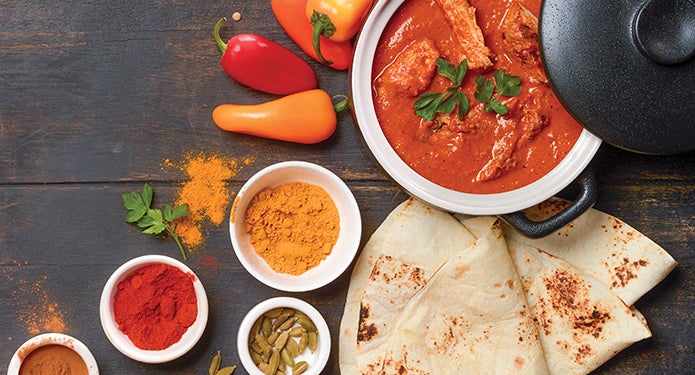As the mashup phenomenon continues, Indian flavours offer a prime opportunity to create first-to-market differentiation.
Indian food isn’t new to Canada, but it hasn’t emerged onto mainstream menus yet. For the consumers who love the rich, aromatic flavours of India, the fact that it hasn’t made big moves has been a bit of a mystery. But for the majority of consumers here, those big flavours are just a bit too exotic—too authentic. Today, those flavour-forward, craveable Indian ingredients are finding their way onto mainstream menus through the macro trend of the “mashup.”
Diners are now familiar with that idea, perhaps first introduced when Korean mashed together with Mexican a number of years ago, thanks to chef Roy Choi and Kogi Taco in Los Angeles. That same idea—taking something familiar and combining it with the adventurous—has defined the evolution of modern North American menus. Those principles are now being applied to Indian cuisine. The result? A huge opportunity for clear menu differentiation, highlighting Indian-inflected versions of popular dishes like burgers, fries, wings, burritos and salads.
“Mainstream restaurants are starting to realize that these types of flavour adapt very well and can help differentiate their menus,” says Eric Caron, Corporate Chef for Gordon Food Service in Quebec. Why? Because of the rich contrasts of textures and flavours, and the big opportunity in plant-based items that can help drive low cost menu items. Indeed, plant-based dishes are finding favour with many diners, particularly younger ones, so it makes sense to look to a cuisine that inherently features pulses and produce in flavour-forward ways.
Tapping into the vibrant flavours of the Indian pantry gives chefs a rich playground. “By playing with Indian flavours within mashed-up recipes, it allows restaurants to adapt perfectly to customer needs,” says Caron. It makes the flavours more accessible. These chefs and their creative, memorable menus are setting the stage for midscale and fast casual operators to incorporate Indian mashups onto their menus. It’s a significant opportunity for first-to-market menu distinction.
Menu translations
India’s pantry is loaded with high-impact flavours that work beautifully in a number of classic favourites, from a poutine topped with chicken tikka masala to a tamarind-glazed shrimp taco with a harissa yogurt drizzle.
Bombay Street Food, Toronto
The Tandoori Chicken Wings here are based on the famous chicken lollipops found in local Bombay restaurants. They serve up the fan favourite chicken wing with an Indian accent. The wings are served with a spicy yogurt sauce, riffing on the classic ranch or blue cheese dressing in a creative, craveable way.
Additional menu examples:
- Masala Omelette with Roti: Eggs seasoned with onions, coriander, ginger, tomatoes, chopped potatoes and spices, served with a housemade roti
- Cardamom Kiss Iced Coffee: Signature BSF house blend scented with cardamom and sweetened with condensed milk
Holi Masala, Vancouver
“Colourfully creative Indian food” is how this Vancouver-based food truck is described. They take familiar dishes, like bowl builds and poutine, and spin them into entirely new offerings with Indian flavours. The Butter Chicken Poutine is one example, leveraging the craveable profile of butter chicken into a beloved presentation.
Additional menu examples:
- Chicken Tikka Tacos on paratha bread
- Tandoori Chicken Sliders with masala fries
Le Balthazar Resto-Pub, Quebec
“We’ve seen so many microbreweries come on the scene, like this place,” says Caron. “Indian mashups work perfectly here because Indian flavours pair so well with craft beers.” The Quinoa Burger is a great example, spiced with turmeric and cumin, and finished with a smoked paprika mayonnaise.
Indian Accent, New York City
We saw great flavour lessons at Indian Accent, where chef Manish Mehrotra combines nostalgic Indian dishes with global influences. Mehrotra serves classic Indian kolchas (stuffed dough pockets), offering hoisin duck, pastrami or butter chicken as the filling.
Additional menu examples:
- Sweet Pickle Baby Back Ribs with sun-dried mango, onion seeds, black pepper pork, curd rice
- Shorba (pumpkin soup) with blue cheese and naan
a Roqa, New York
Chef Gaurav Anand describes his inventive mash-up menu as “Indian flavours with a global palate.” His Habanero Tikka is a great example, where he serves a chicken kebab with the tomato-based tikka, but infuses habanero for a dynamite kick. He also makes his own version of chicken wings called chicken chops, featuring the drumstick, gram flour chutney, with a rum flambé.
Additional menu examples:
- Vindaloo Momos: Pork dumplings, bacon crumble, green apples, vindaloo sauce
- Duck Leg Confit with Mappas coconut curry, string hoppers, poppadoms










